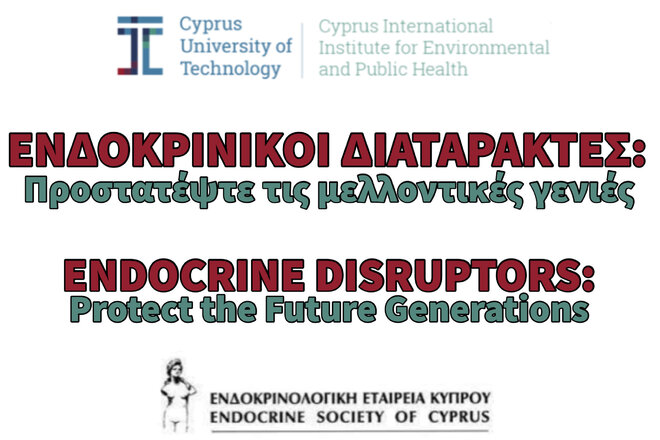28/11/2023, 9:01 π.μ.
I added references to further support the petition.
New petition description:
Στις 07 Νοεμβρίου 2023, κλινικοί ιατροί, ακαδημαϊκοί δημόσιας υγείας και επιστημών υγείας, επαγγελματίες υγείας, νεαροί ερευνητές και φοιτητές θα βρεθούμε στις εγκαταστάσεις του Διεθνούς Ινστιτούτου Κύπρου για την Περιβαλλοντική και Δημόσια Υγεία, στο Τεχνολογικό Πανεπιστήμιο Κύπρου μαζί με την Ενδοκρινολογική Εταιρεία Κύπρου, για την Κυπριακή Διακήρυξη για τους Ενδοκρινικούς Διαταράκτες. Στη βάση μακροχρόνιων συσσωρευμένων επιδημιολογικών στοιχείων, θα ενώσουμε τις φωνές μας για να διακηρύξουμε την άμεση ανάγκη παρεμβάσεων μείωσης του κινδύνου για την ανθρώπινη υγεία που σχετίζεται με τις επιπτώσεις των ενδοκρινικών διαταρακτών (endocrine disrupting chemicals, EDCs) και ιδιαίτερα αυτών που αφορούν τις ευάλωτες ομάδες πληθυσμού. Η ενημέρωση, ευαισθητοποίηση και γενικότερα η διαφώτιση του κοινού, σχετικά με τις επιπτώσεις των ενδοκρινικών διαταρακτών στην ανθρώπινη υγεία και στα οικοσυστήματα θεωρείται επιβεβλημένη για όλες τις ηλικιακές ομάδες.
Πιστεύουμε ότι είναι ένα πολύ σημαντικό θέμα δημόσιας υγείας, το οποίο ποτέ στην Κύπρο δεν έχει συστηματικά μελετηθεί, και καλούμε τα αρμόδια κυβερνητικά τμήματα να συγκροτήσουν και να εφαρμόσουν ένα στρατηγικό σχέδιο ελέγχου των ενδοκρινικών διαταρακτών και αντιμετώπισης των επιπτώσεών τους στην υγεία και στο περιβάλλον στη βάση των πιο κάτω στοιχείων.
Για περισσότερες πληροφορίες, διαβάστε την Κυπριακή Διακήρυξη για τους Ενδοκρινικούς Διαταράκτες και τις Επιπτώσεις τους στην Ανθρώπινη Υγεία και στα Οικοσυστήματα
On 07 November 2023, clinicians, public health and health sciences academics, health care professionals, young researchers and students met at the premises of the Cyprus International Institute for Environmental and Public Health at the Cyprus University of Technology, together with the Cyprus Endocrine Society to sign and first-publicize the Cyprus Declaration on Endocrine Disruptors. Based on long-term accumulated epidemiological evidence, we join our voices to proclaim the urgent need for interventions to reduce the risks to human health associated with the exposures to endocrine disruptors or endocrine disrupting chemicals (EDCs), and particularly those affecting vulnerable population groups. Information, awareness and general public enlightenment regarding the effects of endocrine disruptors on human health and ecosystems is considered imperative for all age groups.
We believe that this is a very important public health issue, which has never been systematically studied in Cyprus, and we call on the relevant government departments to establish and implement a strategic plan to control endocrine disruptors and address their effects on health and the environment.
For more information, read the Cyprus Declaration on Endocrine Disruptors and their Impact on Human Health and Ecosystems
1. Gore AC, Chappell VA, Fenton SE, et al. EDC-2: The Endocrine Society's Second Scientific Statement on Endocrine-Disrupting Chemicals. Endocr Rev. 2015:er20151010.
2. Trasande L, Zoeller RT, Hass U, et al. Estimating burden and disease costs of exposure to endocrine-disrupting chemicals in the European union. J Clin Endocrinol Metab. 2015;100(4):1245-1255.
Neue Begründung:
Οι ενδοκρινικοί διαταράκτες (EDCs) είναι κυρίως χημικές ουσίες που μιμούνται ή εμποδίζουν τη δράση των φυσικών ορμονών στο ανθρώπινο σώμα, και βρίσκονται παντού στην καθημερινή μας ζωή. Οι κύριες ομάδες EDCs είναι διάφοροι πλαστικοποιητές που βρίσκονται σε πλαστικά προϊόντα και υλικά συσκευασίας τροφίμων, αλλά και διάφορα φυτοφάρμακα. Επίσης, βρίσκονται σε προϊόντα προσωπικής φροντίδας, όπως καλλυντικά ή προϊόντα προσωπικής υγιεινής, π.χ. σαμπουάν. Οι EDCs είναι ιδιαίτερα επικίνδυνοι κατά την περίοδο πριν και κατά την κύηση, όπως επίσης και κατά την ανάπτυξη και εξέλιξη των παιδιών, και έχουν συσχετισθεί με αυξημένο κίνδυνο εμφάνισης διάφορων καρκίνων ή εγκεφαλικής βλάβης σε όλες τις ηλικίες.
Οι EDCs έχουν κάποια ιδιόμορφα χαρακτηριστικά τοξικότητας. Οι αρνητικές τους επιπτώσεις στην υγεία μπορεί να εκδηλωθούν ακόμη και σε εξαιρετικά χαμηλές συγκεντρώσεις (δόσεις) EDCs, σε επίπεδα που μπορεί να θεωρούνται ασφαλή για μεμονωμένα χημικά που δεν έχουν τα χαρακτηριστικά των EDCs. Αυτό υποδεικνύει ότι ειδικά για τα EDCs:
1. Ακυρώνεται το κλασσικό θεώρημα της τοξικολογίας ότι «η δόση κάνει το δηλητήριο»
2. Είναι πολύ δύσκολο να προσδιοριστούν ασφαλή όρια συγκεντρώσεων EDCs για την ανθρώπινη υγεία.
Για περισσότερες πληροφορίες, διαβάστε την Κυπριακή Διακήρυξη για τους Ενδοκρινικούς Διαταράκτες και τις Επιπτώσεις τους στην Ανθρώπινη Υγεία και στα Οικοσυστήματα
Endocrine disruptors (EDCs) are mainly anthropogenic chemicals that mimic or block the action of natural hormones in the human body, and are found everywhere in our daily lives. The main groups of EDCs are plasticisers found in plastic products and food packaging materials, and pesticides. They are also found in personal care products, such as cosmetics or personal hygiene products, e.g. shampoos. EDCs are particularly dangerous during the pre- and post-pregnancy period, as well as during the growth and development of children, and have been associated with an increased risk of various cancers or brain damage at all ages.
EDCs have some peculiar toxicity characteristics. Adverse health effects can manifest at exceptionally low concentrations (doses) of EDCs, even at levels that might be deemed safe for other chemicals lacking EDC characteristics. This suggests that for EDCs in particular:
1. The classical toxicological theorem that "the dose makes the poison" is invalidated
2. It is very difficult to determine safe concentration limits of EDCs for human health.
For more information, read the Cyprus Declaration on Endocrine Disruptors and their Impact on Human Health and Ecosystems
1. Gore AC, Chappell VA, Fenton SE, et al. EDC-2: The Endocrine Society's Second Scientific Statement on Endocrine-Disrupting Chemicals. Endocr Rev. 2015:er20151010.
2. Trasande L, Zoeller RT, Hass U, et al. Estimating burden and disease costs of exposure to endocrine-disrupting chemicals in the European union. J Clin Endocrinol Metab. 2015;100(4):1245-1255.
Signatures at the time of the change: 2
